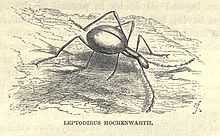Leptodirus hochenwartii
| Leptodirus hochenwartii | |
|---|---|
 | |
| Conservation status | |
| Not evaluated (IUCN 3.1) | |
| Scientific classification | |
| Kingdom: | Animalia |
| Phylum: | Arthropoda |
| Class: | Insecta |
| Order: | Coleoptera |
| Suborder: | Polyphaga |
| Family: | Leiodidae |
| Genus: | Leptodirus |
| Species: | L. hochenwartii |
| Binomial name | |
| Leptodirus hochenwartii Schmidt, 1832 | |
Leptodirus hochenwartii, or L. hohenwarti,[1] is a cave beetle in the family Leiodidae and the only species in the genus Leptodirus. It is a true troglobite, adapted to the life underground and unable to survive outside. Its distinguishing features are slender thorax, elongated legs and antennae, the absence of pigment in the integument, and completely reduced eyes. But perhaps the most striking feature are the domed elytrae which cover the abdomen completely and give it a round (so-called "physogastric") appearance.
It lives predominantly in large caves where the temperature does not exceed 12 °C.[2] Its ecology is largely unknown, but the specimens were seen feeding on carcasses of different cave animals and other organic material. Even less is known about its life history; the only study done so far determined that it reproduces and grows slowly. Females lay a small number of relatively large eggs which take a long time to develop. The number of larval instars is reduced to only one, and the larvae do not feed before moulting.[3]
Taxonomy and range
L. hochenwartii is endemic to western Dinaric Alps. Six subspecies are currently recognized:[2]
- L. hochenwartii hochenwartii Schmidt, 1832
- L. hochenwartii reticulatus J. Müller, 1906
- L. hochenwartii schmidti (Motschoulsky, 1856)
- L. hochenwartii croaticus Pretner, 1955
- L. hochenwartii velebiticus Pretner, 1970
- L. hochenwartii pretneri Müller, 1926
Of those, three are found in Slovenia, and the others are found in Croatia.[4][5] The southernmost known location is Velebit range in Croatia where subspecies L. h. velebiticus was described, and subspecies L. h. reticulatus was originally found in Grota Noe near Trieste (Italy).[2] The exact status of several subspecies and forms is problematic to determine because specimens can differ significantly in physical characteristics even within the same population.
Research history

The animal was first found in 1831 by Luka Čeč, an assistant to the lamplighter, when exploring the newly discovered inner portions of the Postojna cave system in southwestern Slovenia.[2][6] He gave it to Earl Franz von Hohenwart who was unable to determine the species, and gave the specimen in turn to Ferdinand J. Schmidt, a naturalist from Ljubljana. Schmidt recognized the beetle as a new species and described it in the paper Illyrisches Blatt (1832).[7] He named it Leptodirus Hochenwartii after the donor, and also gave it Slovene name drobnovratnik and German Enghalskäfer, both meaning "slender-necked (beetle)".[8] The article represents the first formal description of a cave animal (the olm, described in 1768, wasn't recognized as a cave animal at the time).[2][9] Subsequent research by Schmidt revealed further previously unknown cave inhabitants, which aroused considerable interest among natural historians. For this reason, the discovery of L. hochenwartii (along with the olm) is considered as the starting point of speleobiology as a scientific discipline.[6]
Conservation
Due to its limited range and slow reproduction, L. hochenwartii is considered rare and vulnerable, despite the fact that density in some caves can be high. As such, the species is included in the Slovenian Red list of threatened species (category R).[10] Additionally, it is included in the Annex II of the EU Habitats Directive (92/43/EEC);[11] on this basis, 15 areas of conservation (pSCI) are established in Slovenia which include the majority of known localities.[2]
Notes and references
- ↑ The name is a source of some confusion; the beetle was originally named Leptodirus Hochenwartii, but the specific name is linguistically incorrect, and there are several spelling variants of the name of the person it was named after. Many sources therefore write it as hohenwarti.
- ↑ 2.0 2.1 2.2 2.3 2.4 2.5 Vrezec A. et al. (2007) Monitoring populacij izbranih ciljnih vrst hroščev (končno poročilo) (Monitoring of selected populations of target beetle species). Natura 2000 report. (Slovene)
- ↑ Deleurance-Glaucon S. (1963). "Resherches sur les Coleopteres trolobites de la sousfamille des Bathysciinae". Ann. Sci. Natur. Zool. 12(5): 1-172, as quoted in Vrezec et al. (2007).
- ↑ Polak S. (2004). Leiodidae (working version). Slovensko entomološko društvo Štefana Michielija. Accessed 20.11.2007.
- ↑ Skaberne B. Drobnovratnik. Ljubljana: Umanotera. Accessed 2007-11-20. (Slovene)
- ↑ 6.0 6.1 "Narrow-necked" blind cave beetle. Slovenian museum of natural history. Accessed 2009-03-16.
- ↑ Schmidt F. "Beitrag zu Krein's Fauna". Illyrisches Blatt nr. 3, 21st January 1832. Digitized version at the Digital library of Slovenia. (German)
- ↑ Mader B. (2003). Archduke Ludwig Salvator and Leptodirus hohenwarti from Postonjska jama. Acta carsologica 32(2): 290-298.
- ↑ Polak S. (2005). "Importance of discovery of the first cave beetle Leptodirus hochenwartii Schmidt, 1832." . Endins 28 (2005).
- ↑ Slovenian official gazette (2002). no. 82, tuesday 24 september 2002. (Slovene)
- ↑ EU Habitats directive (1992). . European Commission